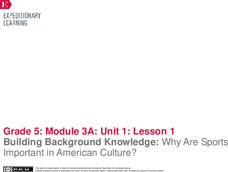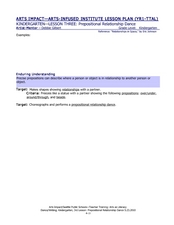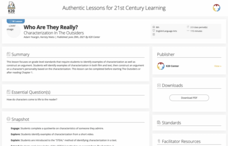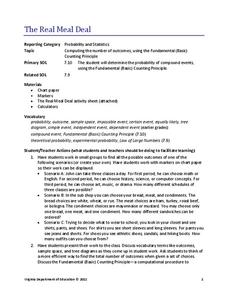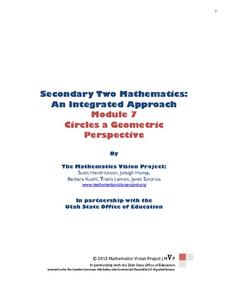EngageNY
Building Background Knowledge: Why Are Sports Important in American Culture?
What makes sports so special to many Americans? Scholars ponder the question as they participate in a gallery walk, immersing themselves in images and texts about sports. Pupils also complete a vocabulary strategies anchor chart to...
K20 LEARN
The Power of Poetry: Perspectives in Poetry
What do Abraham Lincoln, Dr. Martin Luther King, Jr., and Amanda Gordon have in common? They all believe in the power of words—the power of words to create change. After analyzing the rhetorical strategies in several poems and speeches,...
Curated OER
Prepositional Relationship Dance
Students learn the meaning of prepositions through movement. In this dance lesson plan, students choreograph a piece showing that they understand the meaning of various prepositions.
Illustrative Mathematics
What’s Missing?
Now you see them, now you don't! This fun peek-a-boo activity engages young mathematicians in developing their ability to compose and decompose numbers. After being presented with a series of counters, children close their eyes while the...
Curated OER
The Trash We Pass
Where does our garbage go? What is the difference between a recyclable and non-recyclable item? Pose these important, but often overlooked, questions to your class and invite them to consider the lasting and damaging effects of the...
EngageNY
Text-Dependent Questions and Making a Claim: Digging Deeper into Paragraphs 20–23 of Steve Jobs’ Commencement Address (and connecting to Chapter 11)
In preparation for the unit exam, groups employ the strategies they have been practicing to formulate an interpretative claim about the connections between Christopher Paul Curtis's " Bud, Not Buddy, and Steve Jobs' 2005 Stanford...
PBS
Garden Grade 6 Area and Perimeter
Engage young mathematicians in applying their knowledge of area and perimeter with a fun geometry lesson. Through a series of problem solving exercises, children use their math knowledge to design different-sized garden...
EngageNY
Grade 10 ELA Module 3: Unit 3, Lesson 4
Always try to make an excellent first impression. As scholars begin to write their argumentative essays, they learn the importance of a good introduction. Writers also begin to add in-text citations to their papers. After reading a model...
K20 LEARN
Who Are They Really?: Characterization In The Outsiders
Ponyboy, Johnny, Winston, and Darry come alive in a lesson that focuses on the details S. E. Hinton uses to characterize the Greasers and the Socials. The class first observes the actors' words; the thoughts revealed their effect on...
Curated OER
Worth a Thousand Words
First graders examine the significance of the American bison to the American Indians of the Great Plains. They create a story in pictographs in the style of American Indians of the Plains.
Curated OER
Winning the Vote for Women
Students read and respond to the text, Mama Went to Jail for the Vote. In this literary response lesson, students are introduced to vocabulary terms and read the book. Students discuss various text-to-self connections they made to the book.
Orange County Department of Education
Black Cowboy, Wild Horses
Fifth graders read the selection Black Cowboy, Wild Horses and identify characteristics of self-discipline shown by story's main character, Bob Lemmons. Students then identify some of their own traits of self-discipline and reflect upon...
Curated OER
The Piano
Second graders read The Piano and become familiar with racial discrimination. In this racial discrimination book lesson, 2nd graders answer comprehension question to focus on the importance of the book. Students discuss the...
Virginia Department of Education
The Real Meal Deal
Burgers and salads and sodas, oh my! Scholars use a menu to investigate the Fundamental Counting Principle. They create tree diagrams to illustrate the number of possible choices for each given scenario.
Curated OER
Introduction to the Visual Thesaurus
Students examine the basic functions of the online Visual Thesaurus, exploring how simple words may sometimes have multiple meanings. In small groups they select words and explore the Visual Thesaurus, and write a short play using the...
Curated OER
The Game of Persuasion
Students study vocabulary words and explore persuasive speaking. In groups, they support a given argument and generate ideas for a a persuasive speech. They discuss powerful words and strategies for persuasion. Students write a...
Curated OER
Defining Moments
Seventh graders use context clues to define words. In this language arts lesson, 7th graders engage in a class discussion regarding how we determine the meaning of words that we aren't familiar with. Then, students complete a very good...
Curated OER
Finding the Main Idea
Being able to identify the main idea in a text is an essential comprehension skill. After the term is defined, viewers examine a series of paragraphs and are asked to identify the main idea and the supporting details.
Curated OER
Kid-Code: Developmentally Appropriate Spelling
Carefully balanced, developmentally appropriate spelling lessons and expectations can keep young writers focused!
Curated OER
Sneetches: Diversity of Learners
For Learners wanting to practice verbal/linguistic intelligence, any Dr. Seuss book is an excellent text for examining rhyming words. They explore words that rhyme with bully, mean, snooty, nasty, tease, harass, hurt.
Curated OER
Algebra...Your Second Language
Help learners translate word problems into algebraic equations. They will rewrite words using symbols and evaluate algebraic expressions using real life scenarios, animation sequences, video presentations, and activities to help students...
Facing History and Ourselves
Tactics of Nonviolence
Students analyze the direct action tactics of nonviolence. As a class, they distinguish between a strategy and a tactic and identify tactics used during the civil rights movement. They relate these tactics and how they might be used to...
Mathematics Vision Project
Circles: A Geometric Perspective
Circles are the foundation of many geometric concepts and extensions - a point that is thoroughly driven home in this extensive unit. Fundamental properties of circles are investigated (including sector area, angle measure, and...
Curated OER
Double Jeopardy-Homophones
Second graders identify homophones as words that sound alike but have different meanings. They, given a pair of homophones, are to explain the meanings of the words using gestures, role playing, or drawing a picture with their partner.


